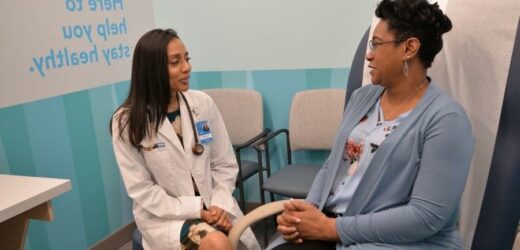Breast cancer impacts Black women in ways that are different and more devastating than their counterparts.
“Black women are a special group within the demographic of people trying to be screened for breast cancer and who we are trying to detect early breast cancer in,” said Dr. Kavita Patel, Chief of Radiology At Lenox Health Greenwich Village Northwell Health. The distinction is made “for a couple of reasons which include that their mortality rate is actually much higher than that of the general population.”
According to the American Cancer Society “screening reduces mortality for cancers of the breast, colon, rectum, cervix, and lung.” Dr. Patel and Jessica Shepherd, MD, Verywell Health’s Chief Medical Officer shared everything you need to know about getting a mammogram to screen for breast cancer with ESSENCE.
Breast cancer can affect anyone no matter their gender and caregivers are affected as well so this information is vital for everyone in your household.
Find out how to schedule a mammogram, what you can expect during your mammogram and what takes place afterwards below.
You Can Assess Your Risks
Mammograms can not be scheduled without a prescription from a physician. They make their recommendations for these prescriptions based on risk factors, including age.
“The U.S. Preventive Services Task Force (USPSTF) recommends delaying screening mammograms until the age of 50 but ultimately, the choice to get a mammogram is up to the individual patient. If you’re concerned about a symptom you’re experiencing or would like a checkup in general, don’t be afraid to speak up and ask your doctor if a mammogram would be right for you,” said Dr. Shepherd.
Dr. Patel recommended that those who do not meet the age requirements for mammography consider assessing their risks on their own and taking any information they obtain to their doctor.
“There are various tools out there on the internet,” she said. She explained that these include “risk-based calculators that have been developed by various cancer based organizations in which you can plug in certain historical facts about yourself, like your family history, your history of other diseases, your weight, your height,” and “even certain questions like when you first had your period, whether you not or not, you had children questions like this, and the answers to those questions will determine your risk for developing breast cancer.”
“The average risk, you know, for somebody who is not at elevated risk is 15% over the course of their life,” she added. “If your number is 20% or above, then you are considered to be in a quote unquote high risk category. And once you fall into that high risk category, then it is appropriate for you to start your mammography screening at an earlier age than the average population of the average woman.”
At every point during an interaction with a healthcare professional you are permitted to ask questions. Dr. Shepherd noted engaging in the process can help patients achieve satisfactory results. “Studies show that women are often happiest with their decisions when they are made with the guidance of a trusted health professional through a process called shared decision-making,” she said. If you don’t feel comfortable speaking up to your current healthcare provider you can access another one by turning to your social or professional network for a recommendation. “It’s important for patients to feel comfortable where they go and it’s important for patients to get information from people that they trust,” said Dr. Patel. It has been reported by the National Library of Medicine that “pain can deter asymptomatic women from continued breast cancer screening attendance,” but Dr. Patel reminded us that the process is designed to be as accurate as possible. “Part of doing the mammogram and part of our ability to obtain accurate, crisp, and clear images, which we can see properly requires us to compress the breast. It requires it to be compressed within two paddles so that we decrease the thickness of the breast and the x-ray beam can penetrate through the tissue. And the radiologist can obtain all the information to be able to identify whether there’s something of concern or not. So compression is a very important part of performing a mammogram,” she said. Dr. Shepard walked us through the process step-by-step. “When you are ready for your test, a radiology technician will take you back into the mammogram suite. You may have markers placed on your breast. These are used for a number of different reasons, such as to mark nipples, moles, scars, and any lumps or areas of pain you have noticed,” she said. “The test is usually performed while you are standing. The machine has handles you can grasp to help you remain still while the images are taken. For those who are unable to stand, sitting mammography may also be done. When the test begins, your technician will help you place your breast between two plates. These plates are then compressed, squeezing your breast as the images are taken.” “It can be uncomfortable,” Dr. Patel admitted before revealing that there are tools available to make the process a tad more bearable. “We do have special padded compression paddles that can try to make you more comfortable and to try to diminish the discomfort that you may feel during that process.” “Though the mammogram itself usually takes around 10 to 15 minutes to complete, plan on spending at least an hour at your appointment to check in and afford your radiologist time to review your images. In general, a diagnostic mammogram often takes longer than a screening mammogram, as special views are frequently done to evaluate an abnormal area,” said Dr. Shepherd. Dr. Shepherd revealed a wardrobe change might help as well. “If you do feel uncomfortable, wearing a comfortable sports bra or camisole, rather than a tightly fitted underwire bra, may provide some relief,” she said. No matter what the results of your mammogram you will be contacted by the facility and your prescribing physician. The information will be relayed to you in writing but you will have an opportunity to ask specific questions. “After your mammogram, a radiologist will review your images and compare these with any previous mammograms you have had. The time it takes until your results are available can vary, and, with some clinics, it may take up to a month before a written report is sent to you,” said Dr. Shepherd. When you get that report you can ask as many questions as you want about it. “It’s important to know that there are some federal standards about how results are communicated to women about their mammogram results. And so there is something called the mammography quality standards act called MQSA, which requires that every woman who’s had a mammogram receive a letter written in lay terms within 30 days, that explains to them the results of their mammogram. So it’s important that you know that you will be receiving a letter from the facility,” said Dr. Patel. Source: Read Full ArticleYou Can Ask Questions
You Can Make The Process More Comfortable
You Should Dress Comfortably And Allot Enough Time
You Should Expect Follow-Up Communication


